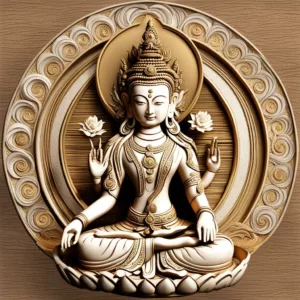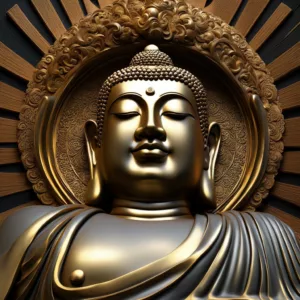64 Siddhi Powers and how to attain them

Siddhi means power or ability attained through spiritual effort, mainly yogic esoteric practice. The powers exist in both Buddhism and Hinduism. Buddhism has both relative and ultimate siddhi: the 4 karmas, and complete enlightenment.
Table of Contents
Secrets of Meditation for Anxiety
Like millions of people, you may have suffered from anxiety for years. Meditation, yoga, peaceful music – it never works. It takes too long, and it’s not stable. Why? Because peace is treated as a cause for freedom, but it’s not – it’s the result. The cause to free yourself from anxiety is completely different.
Click now to Overcome Anxiety for good.
Siddhi / Meditative Powers Summary
| Entity | Description |
|---|---|
| Siddhi | (Sanskrit) accomplishment, paranormal power |
| Religion/Practice | Hinduism, Buddhism, Sikhism, Jainism |
| Concept | * An ability or power developed through spiritual practice and discipline * Can be mundane or supernatural * Seen as a sign of spiritual progress |
| Types | * There are numerous lists and classifications of siddhis across traditions. Some common types include: * Mundane siddhis: Healing, levitation, strength, longevity. * Supramundane siddhis: Clairvoyance, clairaudience, telepathy, psychokinesis. |
| Views on Siddhis | * Views on the importance and pursuit of siddhis vary. * Some traditions see them as potential distractions from the ultimate goal of liberation. * Others see them as beneficial tools to help others or alleviate suffering. |
| Attainment | * Believed to be attained through intense spiritual practices, meditation, and austerities. * Often associated with advanced practitioners or enlightened beings. |
| Importance | * The concept of siddhis holds a complex place within Indian religions. * They may be seen as: * A sign of spiritual progress * A potential distraction * A tool for helping others |
| Additional Notes | * The existence and nature of siddhis are debated and there’s no scientific evidence to support them. * The focus in many traditions is on inner transformation rather than acquiring external powers. |
Siddhi in Vajrayana Buddhism
| Abilities | Explanation |
|---|---|
| Clairvoyance | The ability to gain information about an object, location, or event beyond normal human perception. |
| Levitation | The power to rise or float in the air, defying gravity and earthly constraints. |
| Bilocation and Astral Projection | The capacity to be in two places at the same time or project one’s consciousness to another location. |
| Materialization | The manifestation of physical objects or substances seemingly out of thin air. |
| Access to Memories from Past Lives | The ability to recall and access memories from previous lifetimes or incarnations. |
Relative and Ultimate Siddhi
In Hinduism and Buddhism, Siddhi refers to the spiritual powers or supernatural abilities attained through rigorous spiritual practices such as meditation or yoga. It is seen as a state of realization or enlightenment. There are two types of Siddhi: Relative and Ultimate.
1. Relative Siddhi:
Relative Siddhi refers to the acquisition of supernatural powers that can be achieved in the physical world through dedicated spiritual or yogic practices. These include abilities like clairvoyance, clairaudience, telepathy, levitation, invisibility, etc. They are called “relative” because they exist within the realm of the relative world or physical universe. They are subject to the laws of karma and are considered transient because they may disappear once the accumulated merit that led to their acquisition is exhausted.
An important siddhi is the power to overcome negative emotions (kleshas), such as anxiety.
The highest relative siddhis are the 4 karmas – buddha activities. These are used to benefit sentient beings: Pacifying, Enriching, Magnetizing, and Destroying.
2. Ultimate Siddhi
Ultimate Siddhi, also known as Parama Siddhi, refers to the ultimate spiritual goal in Hinduism and Buddhism – liberation or enlightenment. Unlike relative siddhis, it is not about acquiring supernatural powers or abilities, but about transcending the cycle of birth and death, realizing one’s true nature and union with the divine or the ultimate reality. It is considered “ultimate” because it represents the final goal of the spiritual journey, beyond which there is no further attainment. It is not transient but permanent, and not subject to the laws of karma.
In general, spiritual traditions often warn practitioners not to become attached to or distracted by the attainment of relative siddhis, as they can lead one away from the pursuit of the ultimate goal of spiritual liberation.
Siddhi Meaning
In Tantric Buddhism, the concept of Siddhi holds a profound place. Siddhi, derived from the Sanskrit word सिद्धि, encompasses a range of mystical or supernatural attainments, often associated with spiritual practices and asceticism. It signifies the realization of extraordinary powers or abilities achieved through dedicated spiritual discipline and mastery of esoteric techniques.
Siddhi Meaning in Sanskrit
In the sacred language of Sanskrit, Siddhi carries layers of significance beyond its mere translation. In Sanskrit, Siddhi represents not only the attainment of supernatural powers but also the realization of spiritual perfection and the ultimate goal of self-realization. It encapsulates the transformative journey of the practitioner from a state of ordinary consciousness to an elevated and awakened state.
Siddhi Meaning in English
When translated into English, Siddhi can be understood as “accomplishment,” “perfection,” or “attainment.” In the context of Tantric Buddhism, it refers to the extraordinary achievements and powers cultivated by adept practitioners on their spiritual journey.
Siddhi in Hindi
In Hindi, Siddhi retains a similar meaning, emphasizing the idea of accomplishment or success. The term is embedded in the spiritual and cultural ethos of India, reflecting the pursuit of higher states of consciousness and mystical abilities through dedicated practice.
Siddhi Yoga
Siddhi Yoga, also known as “Yoga of Perfection,” is a spiritual concept in Hinduism, Buddhism, and Jainism, referring to a state of enlightenment where an individual attains supernatural powers or spiritual insights. The term “Siddhi” translates to “perfection” or “accomplishment,” while “Yoga” refers to the path or practice leading towards such a state.
Siddhi is believed to be a divine gift or the result of intense meditation and yoga practice. It includes various supernatural abilities, such as clairvoyance, levitation, bilocation, becoming as small as an atom, materialization, having access to memories from past lives, and more. However, in the spiritual tradition, these powers are seen as distractions from the path of spiritual enlightenment and not the end goal.
In astrology, Siddhi Yoga is a particular combination of planets, days, and nakshatras (lunar mansions) that are considered auspicious for starting new ventures, businesses, marriages, and other important life events. This combination is believed to bring success, prosperity, and happiness.
In the context of yoga practice, the term can refer to a specific sequence or style of yoga aimed at achieving spiritual perfection or awakening the Kundalini energy. These practices often include a combination of meditation, breath control (pranayama), ethical disciplines (yamas and niyamas), physical postures (asanas), and other yogic techniques.
8 Siddhis
While the list of 64 Siddhis is extensive, a subset known as the Ashta Siddhis, or the Eight Siddhis, holds particular significance in Tantric Buddhism. These are:
- Anima (अणिमा): The ability to become infinitely small or subtle.
- Mahima (महिमा): The power to become infinitely large or expansive.
- Garima (गरिमा): The ability to become infinitely heavy.
- Laghima (लघिमा): The power to become weightless or light.
- Prapti (प्राप्ति): The attainment of anything desired.
- Prakamya (प्राकाम्य): The ability to manifest anything at will.
- Isitva (ईशित्व): Sovereignty or lordship over all.
- Vasitva (वासित्व): The power to control all beings and things.
These Eight Siddhis represent a spectrum of metaphysical abilities that, according to Tantric teachings, can be cultivated through rigorous spiritual practice.
64 Siddhis List
Tantric scriptures enumerate a fascinating array of 64 Siddhis, each representing a unique mystical attainment. These powers range from clairvoyance and telepathy to the ability to manipulate the elements and achieve invisibility. The 64 Siddhis are often considered as markers of spiritual progress and mastery over the subtle energies of the mind and body.
| Group | Siddhi Names |
|---|---|
| Anima Siddhis | Aṇimā, Laghimā, Mahimā, Garimā |
| Mahima Siddhis | Prākāmya, Iṣiṭva, Vaśiṭva, Kāmāvasāyitva |
| Laghima Siddhis | Prāpti, Prākāmya, Kāmāvasāyitva, Dūraśravaṇī |
| Garima Siddhis | Śūrāvasāyitva, Prāpti, Prākāmya, Dūraśravaṇī |
| Prāpti Siddhis | Āśīrvādam, Parakāya praveśanam, Kāmāvasāyitva, Iṣṭa sidhi |
| Prākāmya Siddhis | Vasīkaraṇa, Māraṇa, Udvegā, Saṅkṣepaṇa |
| Iṣiṭva Siddhis | Manojaya, Kāmāvasāyitva, Parakāya praveśanam, Vasīkaraṇa |
| Vaśiṭva Siddhis | Manojaya, Kāmāvasāyitva, Saṅkṣepaṇa, Iṣṭa sidhi |
Siddhi Powers
Siddhi powers encompass a broad spectrum of mystical abilities, each reflecting a profound understanding of the interplay between consciousness and the fabric of reality. Some notable Siddhi powers include:
- Telepathy: The ability to communicate thoughts directly without verbal or written means.
- Clairvoyance: Gaining insight or knowledge about distant or unseen events.
- Telekinesis: The power to move or manipulate objects with the mind.
- Levitation: The ability to defy gravity and float or rise above the ground.
- Invisibility: The capacity to make oneself unseen by others.
- Healing: Siddhi powers may include the ability to heal physical and spiritual ailments.
- Shape-shifting: The power to change one’s form or appearance at will.
These powers, considered extraordinary from a conventional standpoint, are viewed in Tantric Buddhism as natural expressions of the heightened spiritual state achieved by advanced practitioners.
How to Attain Siddhi Powers
The attainment of Siddhi powers is not a trivial pursuit but requires unwavering dedication, disciplined practice, and guidance from an experienced teacher. Tantric practitioners engage in a variety of esoteric techniques, including mantra chanting, meditation, ritualistic ceremonies, and breath control, to harness and channel the subtle energies within the body. The path to Siddhi involves purifying the mind, transcending egoic limitations, and establishing a deep connection with the divine energies inherent in the universe.
Attaining siddhi powers in the context of traditional spiritual practices, particularly in Tantric and Yogic traditions, involves a disciplined and dedicated approach. It’s crucial to note that the pursuit of siddhis should align with ethical and spiritual principles, focusing on self-realization and the betterment of oneself and others. Here are general guidelines that individuals may follow:
- Seek a Qualified Guru:
- Find a knowledgeable and ethical spiritual teacher or guru who can guide you through the practices and provide insights into the spiritual path.
- Moral and Ethical Living:
- Practice ethical conduct and moral living. Siddhis are more likely to manifest when one’s actions are aligned with truth, non-violence, compassion, and integrity.
- Asana and Pranayama:
- Engage in physical postures (asanas) and breath control exercises (pranayama) to purify and balance the physical and energetic bodies.
- Regular meditation is crucial for developing concentration and inner stillness. Choose a meditation technique that resonates with you and commit to a consistent practice.
- Mantra and Chanting:
- Utilize the power of sound vibrations through mantra chanting. Specific mantras associated with particular siddhis may be incorporated into your practice.
- Yoga and Tantra Practices:
- Explore advanced yogic and Tantric practices under the guidance of a qualified teacher. This may include Kundalini yoga, mudras, and specific energy channeling techniques.
- Tapas (Austerity):
- Engage in tapas, which involves self-discipline and austerity. This could include fasting, self-control, and other practices to purify the mind and body.
- Develop the ability to visualize clearly. Visualization is a powerful tool in manifesting intentions and cultivating concentration.
- Devotion and Surrender:
- Cultivate a sense of devotion and surrender to a higher power. This can help in transcending the ego and accessing higher states of consciousness.
- Self-Reflection:
- Regularly reflect on your motives and intentions. Siddhis are best approached with humility and a desire for spiritual growth rather than for personal gain or power.
- Patience and Perseverance:
- The development of siddhis is often a gradual process. Be patient, persistent, and maintain a balanced approach to spiritual growth.
- Integrate Wisdom Teachings:
- Study sacred texts, philosophical teachings, and scriptures related to the tradition you are following. Understand the deeper meaning and wisdom behind the practices.
It is essential to approach the pursuit of siddhis with sincerity and a genuine quest for spiritual enlightenment. The focus should be on self-realization and the expansion of consciousness, rather than seeking powers for personal gain or ego gratification. Always remember that the journey is as important as the destination, and the ethical foundation of your practices is paramount.
In conclusion, Siddhi in Tantric Buddhism unveils a mystical realm of extraordinary attainments and spiritual powers. It goes beyond the ordinary boundaries of human experience, offering a glimpse into the potential of the awakened mind and the profound interconnection between the individual and the cosmic forces. Siddhi powers, embedded in the ancient wisdom of Tantric teachings, beckon practitioners to embark on a journey of self-discovery, spiritual mastery, and the realization of profound and transcendent potentials within the vast tapestry of existence.

May all beings be happy
May all beings be peaceful
May all beings be safe
May all beings awaken to the light of their true nature
May all beings be free








